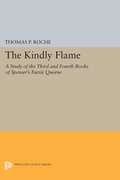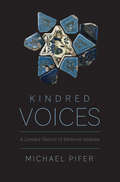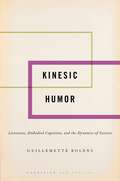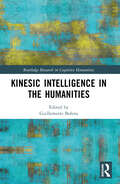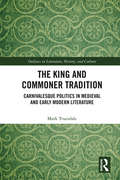- Table View
- List View
Kindler Kompakt: Italienische Literatur, 20. Jahrhundert
Kindler Kompakt präsentiert in handlichen Ausgaben die wichtigsten Autoren und Werke eines Jahrhunderts. Dazu gibt es eine kompakte Einleitung des Herausgebers, der die Epoche verortet, die großen Linien zieht, das Wesentliche zusammenfasst.. - Die Schätze aus Kindlers Literatur Lexikon in handlicher Form.
Kindler Kompakt: Kriminalliteratur
by Christof HamannIn diesem Band findet sich eine Zusammenstellung der bedeutendsten internationalen Kriminalliteratur. Die Einleitung beschreibt, was Kriminalliteratur ausmacht.
Kindler Kompakt: Niederländische und Flämische Literatur
by Holger E. WiedenstriedDie Kindler Kompakt Bände präsentieren in handlicher Form die 30 - 40 wichtigsten Autoren und Werke einer Literatur eines Jahrhunderts. Auf 192 Seiten werden sie vorgestellt. Dazu gibt es eine kompakte Einleitung des Herausgebers. Hier werden die Epochen verortet, die großen Linien gezogen, das Wesentliche zusammengefasst. Das alles handlich und in schöner Form, zweifarbige Gestaltung, lesbarer Satz. Schöne literarische Begleiter in allen Lebenslagen - wer Klassiker kauft, wird von Kindler Kompakt begeistert sein!
Kindler Kompakt: Österreichische Literatur der Gegenwart
Die Kindler Kompakt Bände präsentieren in handlicher Form die 30-40 wichtigsten Autoren und Werke einer Literatur eines Jahrhunderts. Auf 208 Seiten werden sie vorgestellt. Dazu gibt es eine kompakte Einleitung des Herausgebers. Hier werden die Epochen verortet, die großen Linien gezogen, das Wesentliche zusammengefasst. Das alles handlich und in schöner Form, zweifarbige Gestaltung, lesbarer Satz. Schöne literarische Begleiter in allen Lebenslagen - wer Klassiker kauft, wird von Kindler Kompakt begeistert sein!
Kindler Kompakt: Portugiesische Literatur, 20. Jahrhundert
Die Kindler Kompakt Bände präsentieren in handlicher Form die 30 - 40 wichtigsten Autoren udn Werke einer Literatur eines Jahrhunderts. Auf 192 Seiten werden sie vorgestellt. Dazu gibt es eine kompakte Einleitung des Herausgebers. Hier werden die Epochen verortet, die großen Linien gezogen, das Wesentliche zusammengefasst. Das alles handlich und in schöner Form, zweifarbige Gestaltung, lesbarer Satz. Schöne literarische Begleiter in allen Lebenslagen - wer Klassiker kauft, wird von Kindler Kompakt begeistert sein!
Kindler Kompakt: Russische Literatur, 19. Jahrhundert
Die Kindler Kompakt Bände präsentieren in handlicher Form die 30 - 40 wichtigsten Autoren udn Werke einer Literatur eines Jahrhunderts. Auf 192 Seiten werden sie vorgestellt. Dazu gibt es eine kompakte Einleitung des Herausgebers. Hier werden die Epochen verortet, die großen Linien gezogen, das Wesentliche zusammengefasst. Das alles handlich und in schöner Form, zweifarbige Gestaltung, lesbarer Satz. Schöne literarische Begleiter in allen Lebenslagen - wer Klassiker kauft, wird von Kindler Kompakt begeistert sein!
Kindler Kompakt: Schweizer Literatur
by Iso CamartinDie Kindler Kompakt Bände präsentieren in handlicher Form die 30 - 40 wichtigsten Autoren und Werke einer Literatur eines Jahrhunderts. Auf 192 Seiten werden sie vorgestellt. Dazu gibt es eine kompakte Einleitung des Herausgebers. Hier werden die Epochen verortet, die großen Linien gezogen, das Wesentliche zusammengefasst. Das alles handlich und in schöner Form, zweifarbige Gestaltung, lesbarer Satz. Schöne literarische Begleiter in allen Lebenslagen - wer Klassiker kauft, wird von Kindler Kompakt begeistert sein!
Kindler Kompakt: Skandinavische Literatur, 19. Jahrhundert
Kindler Kompakt präsentiert in handlichen Ausgaben die wichtigsten Autoren und Werke eines Jahrhunderts. Dazu gibt es eine kompakte Einleitung des Herausgebers, der die Epoche verortet, die großen Linien zieht, das Wesentliche zusammenfasst.. - Die Schätze aus Kindlers Literatur Lexikon in handlicher Form.
Kindler Kompakt: Spanische Literatur, 20. Jahrhundert
Die Kindler Kompakt Bände präsentieren in handlicher Form die 30 - 40 wichtigsten Autoren udn Werke einer Literatur eines Jahrhunderts. Auf 192 Seiten werden sie vorgestellt. Dazu gibt es eine kompakte Einleitung des Herausgebers. Hier werden die Epochen verortet, die großen Linien gezogen, das Wesentliche zusammengefasst. Das alles handlich und in schöner Form, zweifarbige Gestaltung, lesbarer Satz. Schöne literarische Begleiter in allen Lebenslagen - wer Klassiker kauft, wird von Kindler Kompakt begeistert sein!
Kindly Flame
by Thomas P. RocheScholars have often felt that Books III and IV of Spenser's Faerie Queene were loosely, almost carelessly, structured. Thomas P. Roche, Jr., seeks to show by a close examination of the text that all four books have a logical structure, and that the apparently randomly selected episodes form one complex allegory.Originally published in 1964.The Princeton Legacy Library uses the latest print-on-demand technology to again make available previously out-of-print books from the distinguished backlist of Princeton University Press. These editions preserve the original texts of these important books while presenting them in durable paperback and hardcover editions. The goal of the Princeton Legacy Library is to vastly increase access to the rich scholarly heritage found in the thousands of books published by Princeton University Press since its founding in 1905.
Kindred Brutes: Animals in Romantic-Period Writing (The Nineteenth Century Series)
by Christine Kenyon-JonesExploring the significance of animals in Romantic-period writing, this new study shows how in this period they were seen as both newly different from humankind (subjects in their own right, rather than simply humanity's tools or adjuncts) and also as newly similar, with the ability to feel and perhaps to think like human beings. Approaches to animals are reviewed in a wide range of the period's literary work (in particular, that of Byron, Wordsworth, Coleridge, Keats, Southey, Clare and Blake). Poetry and other literary work are discussed in relation to discourses about animals in various contemporary cultural contexts, including children's books, parliamentary debates, vegetarian theses, encyclopaedias and early theories about evolution. The study introduces animals to the discussions about ecocriticism and environmentalism in Romantic-period writing by complicating the concept of 'Nature', and it also contributes to the debates about politics and the body in this period. It demonstrates the rich variety of thinking about animals in the late-eighteenth and early-nineteenth centuries, and it challenges the exclusion of literary writing from some recent multi-disciplinary debates about animals, by exploring the literary roots of many metaphors about and attitudes to animals in our current thinking. Kindred Brutes constitutes a genuinely original and substantial contribution both to Romantic-period writing and to general debates about animals and the body.
Kindred Brutes: Animals in Romantic-Period Writing (The Nineteenth Century Series)
by Christine Kenyon-JonesExploring the significance of animals in Romantic-period writing, this new study shows how in this period they were seen as both newly different from humankind (subjects in their own right, rather than simply humanity's tools or adjuncts) and also as newly similar, with the ability to feel and perhaps to think like human beings. Approaches to animals are reviewed in a wide range of the period's literary work (in particular, that of Byron, Wordsworth, Coleridge, Keats, Southey, Clare and Blake). Poetry and other literary work are discussed in relation to discourses about animals in various contemporary cultural contexts, including children's books, parliamentary debates, vegetarian theses, encyclopaedias and early theories about evolution. The study introduces animals to the discussions about ecocriticism and environmentalism in Romantic-period writing by complicating the concept of 'Nature', and it also contributes to the debates about politics and the body in this period. It demonstrates the rich variety of thinking about animals in the late-eighteenth and early-nineteenth centuries, and it challenges the exclusion of literary writing from some recent multi-disciplinary debates about animals, by exploring the literary roots of many metaphors about and attitudes to animals in our current thinking. Kindred Brutes constitutes a genuinely original and substantial contribution both to Romantic-period writing and to general debates about animals and the body.
Kindred Voices: A Literary History of Medieval Anatolia
by Michael PiferThe fascinating story of how premodern Anatolia’s multireligious intersection of cultures shaped its literary languages and poetic masterpieces By the mid-thirteenth century, Anatolia had become a place of stunning cultural diversity. Kindred Voices explores how the region’s Muslim and Christian poets grappled with the multilingual and multireligious worlds they inhabited, attempting to impart resonant forms of instruction to their intermingled communities. This convergence produced fresh poetic styles and sensibilities, native to no single people or language, that enabled the period’s literature to reach new and wider audiences. This is the first book to study the era’s major Persian, Armenian, and Turkish poets, from roughly 1250 to 1340, against the canvas of this broader literary ecosystem.
Kinds, Things, and Stuff: Mass Terms and Generics (New Directions in Cognitive Science)
by Francis Jeffry PelletierA generic statement is a type of generalization that is made by asserting that a "kind" has a certain property. For example we might hear that marshmallows are sweet. Here, we are talking about the "kind" marshmallow and assert that individual instances of this kind have the property of being sweet. Almost all of our common sense knowledge about the everyday world is put in terms of generic statements. What can make these generic sentences be true even when there are exceptions? A mass term is one that does not "divide its reference;" the word water is a mass term; the word dog is a count term. In a certain vicinity, one can count and identity how many dogs there are, but it doesn't make sense to do that for water--there just is water present. The philosophical literature is rife with examples concerning how a thing can be composed of a mass, such as a statue being composed of clay. Both generic statements and mass terms have led philosophers, linguists, semanticists, and logicians to search for theories to accommodate these phenomena and relationships. The contributors to this interdisciplinary volume study the nature and use of generics and mass terms. Noted researchers in the psychology of language use material from the investigation of human performance and child-language learning to broaden the range of options open for formal semanticists in the construction of their theories, and to give credence to some of their earlier postulations--for instance, concerning different types of predications that are available for true generics and for the role of object recognitions in the development of count vs. mass terms. Relevant data also is described by investigating the ways children learn these sorts of linguistic items: children can learn how to sue generic statements correctly at an early age, and children are adept at individuating objects and distinguishing them from the stuff of which they are made also at an early age.
Kinesemiotics: Modelling How Choreographed Movement Means in Space (Routledge Studies in Multimodality)
by Arianna MaioraniThis innovative work introduces the interdisciplinary field of research of kinesemiotics, offering a new adaptable model and means of analysis for understanding forms of movement-based communication, such as dance, that use a codified language shared by a community of users. It begins with a theoretical overview and review of existing literature on the main approaches to movement-based communication, specifically dance, which underpin kinesemiotics as an area of study. It reaffirms previous work which established dance as a form of embodied communication in that it encompasses a wide range of semiotic styles and forms shared by communities of "speakers." In collaboration with the English National Ballet, Maiorani employs the genre of ballet as a means through which to understand and analyse some of the key concepts of kinesemiotics, mainly that of space as a semiotic dimension and "motivated movement," or movement with meaning. Supported by automated movement recognition tools from the fields of bio-robotics engineering and computer science, Maiorani argues for ballet’s capacity, when movements are projected into meaningful space, to extend beyond sequences of physical movements to become a meaning making practice. Kinesemiotics advances interdisciplinary research in the fields of social semiotics, media and communication, multimodality, linguistics, and performance studies and will be of particular interest to students and scholars in these areas.
Kinesemiotics: Modelling How Choreographed Movement Means in Space (Routledge Studies in Multimodality)
by Arianna MaioraniThis innovative work introduces the interdisciplinary field of research of kinesemiotics, offering a new adaptable model and means of analysis for understanding forms of movement-based communication, such as dance, that use a codified language shared by a community of users. It begins with a theoretical overview and review of existing literature on the main approaches to movement-based communication, specifically dance, which underpin kinesemiotics as an area of study. It reaffirms previous work which established dance as a form of embodied communication in that it encompasses a wide range of semiotic styles and forms shared by communities of "speakers." In collaboration with the English National Ballet, Maiorani employs the genre of ballet as a means through which to understand and analyse some of the key concepts of kinesemiotics, mainly that of space as a semiotic dimension and "motivated movement," or movement with meaning. Supported by automated movement recognition tools from the fields of bio-robotics engineering and computer science, Maiorani argues for ballet’s capacity, when movements are projected into meaningful space, to extend beyond sequences of physical movements to become a meaning making practice. Kinesemiotics advances interdisciplinary research in the fields of social semiotics, media and communication, multimodality, linguistics, and performance studies and will be of particular interest to students and scholars in these areas.
Kinesic Humor: Literature, Embodied Cognition, and the Dynamics of Gesture (Cognition and Poetics)
by Guillemette BolensThis is an open access title available under the terms of a CC BY-NC-ND 4.0 International license. It is free to read at Oxford Scholarship Online and offered as a free PDF download from OUP and selected open access locations. The triggers of laughter in spoken language or conversation can often be very simple, such as a change in gesture, or in vocal tone or tempo. Speakers and listeners understand these dynamics of gesture through motor cognition and use them to great effect. The causes of laughter and the experience of humor in written texts, however, are less well understood. In Kinesic Humor, Guillemette Bolens offers a cognitive poetics-based study of triggers of laughter in texts, focusing in particular on tonic shifts and gesture in plot and narrative. Bolens shows how literary texts from a variety of periods provide remarkably precise information concerning kinesthesia, the role of tonicity in communication, and the impact of momentum, timing, and tempo on the way in which gestures are processed in human exchanges. She investigates the narrative use of such parameters and how they prompt laughter in a wide-ranging corpus of major authors that includes Chr?tien de Troyes, Cervantes, Milton, Saint-Simon, Rousseau, Sterne, and Stendhal. Using the theory of embodied cognition, Bolens shows how thwarted perceptions and expectations of movements and sensations produce the cognitive shifts typical of humor. Bringing together narratology, cognitive studies, gesture studies, humor studies, and historical context, this book offers original perspectives on important artworks and represents a major contribution to cognitive poetics. Originally published in French as L'Humour et le savoir des corps in 2016, this volume not only brings the work to an English-speaking audience for the first time but expands significantly on the original by analyzing a new corpus of texts and engaging with recent advances in the field to develop a cutting-edge theory of kinesic humor.
Kinesic Humor: Literature, Embodied Cognition, and the Dynamics of Gesture (Cognition and Poetics)
by Guillemette BolensThis is an open access title available under the terms of a CC BY-NC-ND 4.0 International license. It is free to read at Oxford Scholarship Online and offered as a free PDF download from OUP and selected open access locations. The triggers of laughter in spoken language or conversation can often be very simple, such as a change in gesture, or in vocal tone or tempo. Speakers and listeners understand these dynamics of gesture through motor cognition and use them to great effect. The causes of laughter and the experience of humor in written texts, however, are less well understood. In Kinesic Humor, Guillemette Bolens offers a cognitive poetics-based study of triggers of laughter in texts, focusing in particular on tonic shifts and gesture in plot and narrative. Bolens shows how literary texts from a variety of periods provide remarkably precise information concerning kinesthesia, the role of tonicity in communication, and the impact of momentum, timing, and tempo on the way in which gestures are processed in human exchanges. She investigates the narrative use of such parameters and how they prompt laughter in a wide-ranging corpus of major authors that includes Chr?tien de Troyes, Cervantes, Milton, Saint-Simon, Rousseau, Sterne, and Stendhal. Using the theory of embodied cognition, Bolens shows how thwarted perceptions and expectations of movements and sensations produce the cognitive shifts typical of humor. Bringing together narratology, cognitive studies, gesture studies, humor studies, and historical context, this book offers original perspectives on important artworks and represents a major contribution to cognitive poetics. Originally published in French as L'Humour et le savoir des corps in 2016, this volume not only brings the work to an English-speaking audience for the first time but expands significantly on the original by analyzing a new corpus of texts and engaging with recent advances in the field to develop a cutting-edge theory of kinesic humor.
Kinesic Intelligence in the Humanities (Routledge Research in Cognitive Humanities)
by Guillemette BolensThis research collection showcases how kinesic intelligence is fundamental to human communication and our ability to produce complex meaning, exploring its manifestations across a range of humanities disciplines, and connecting our past with our social and cultural future. The book defines kinesic intelligence as a higher-order intellectual competence that allows human beings to interact and grow cognitively and intersubjectively through sensorimotricity and interpersonal movement. Understood in this way, kinesic intelligence can offer insights into the development of humans’ meaning-making abilities and in turn, society and culture more broadly. Recognizing the power of the humanities in furthering sociocultural development, the collection features perspectives from scholars across a range of topics, including the multimodality of language acquisition in children; young adults in clinical psychology and medical humanities; nonverbal communication in history; legal language and reasoning; literature and cognitive studies; the internet and multispecies anthropology; and sensoriality in history and art. Foregrounding the impact of the humanities in promoting new understandings of human intelligence, this volume will be of interest to scholars in cognitive literary studies, multimodality, anthropology, history, medical humanities, and those with an interest in the real-world impact of the humanities.
Kinesic Intelligence in the Humanities (Routledge Research in Cognitive Humanities)
This research collection showcases how kinesic intelligence is fundamental to human communication and our ability to produce complex meaning, exploring its manifestations across a range of humanities disciplines, and connecting our past with our social and cultural future. The book defines kinesic intelligence as a higher-order intellectual competence that allows human beings to interact and grow cognitively and intersubjectively through sensorimotricity and interpersonal movement. Understood in this way, kinesic intelligence can offer insights into the development of humans’ meaning-making abilities and in turn, society and culture more broadly. Recognizing the power of the humanities in furthering sociocultural development, the collection features perspectives from scholars across a range of topics, including the multimodality of language acquisition in children; young adults in clinical psychology and medical humanities; nonverbal communication in history; legal language and reasoning; literature and cognitive studies; the internet and multispecies anthropology; and sensoriality in history and art. Foregrounding the impact of the humanities in promoting new understandings of human intelligence, this volume will be of interest to scholars in cognitive literary studies, multimodality, anthropology, history, medical humanities, and those with an interest in the real-world impact of the humanities.
The King and Commoner Tradition: Carnivalesque Politics in Medieval and Early Modern Literature (Outlaws in Literature, History, and Culture #4)
by Mark TruesdaleKing and Commoner tales were hugely popular across the late medieval and early modern periods, their cultural influence extending from Robin Hood ballads to Shakespearean national histories. This study represents the first detailed exploration of this rich and fascinating literary tradition, tracing its development across deeply politicized fifteenth-century comic tales and early modern ballads. The medieval King and Commoner tales depict an incognito king becoming lost in the forest and encountering a disgruntled commoner who complains of class oppression and poaches the king’s deer. This is an upside-down world of tricksters, violence, and politicized feasting that critiques and deconstructs medieval hierarchy. The commoners of these tales utilize the inversion of the medieval carnival, crowning themselves as liminal mock kings in the forest while threatening to rend and devour a body politic that would oppress them. These tales are complex and ambiguous, reimagining the socio-political upheaval of the late medieval period in sophisticated ruminations on class relations. By contrast, the early modern ballads and chapbooks see the tradition undergo a conservative metamorphosis. Suppressing its more radical elements amid a celebration of proto-panoptical kings, the tradition remerges as royalist propaganda in which the king watches his thankful subjects through the keyhole.
The King and Commoner Tradition: Carnivalesque Politics in Medieval and Early Modern Literature (Outlaws in Literature, History, and Culture)
by Mark TruesdaleKing and Commoner tales were hugely popular across the late medieval and early modern periods, their cultural influence extending from Robin Hood ballads to Shakespearean national histories. This study represents the first detailed exploration of this rich and fascinating literary tradition, tracing its development across deeply politicized fifteenth-century comic tales and early modern ballads. The medieval King and Commoner tales depict an incognito king becoming lost in the forest and encountering a disgruntled commoner who complains of class oppression and poaches the king’s deer. This is an upside-down world of tricksters, violence, and politicized feasting that critiques and deconstructs medieval hierarchy. The commoners of these tales utilize the inversion of the medieval carnival, crowning themselves as liminal mock kings in the forest while threatening to rend and devour a body politic that would oppress them. These tales are complex and ambiguous, reimagining the socio-political upheaval of the late medieval period in sophisticated ruminations on class relations. By contrast, the early modern ballads and chapbooks see the tradition undergo a conservative metamorphosis. Suppressing its more radical elements amid a celebration of proto-panoptical kings, the tradition remerges as royalist propaganda in which the king watches his thankful subjects through the keyhole.
The King and I (Shakespeare Now!)
by Philippa KellyA unique exploration of Shakespeare's King Lear, with its themes of banishment, alienation and hope, via a personal memoir that embraces the history of Australia.
The King and I (Shakespeare Now!)
by Philippa KellyA unique exploration of Shakespeare's King Lear, with its themes of banishment, alienation and hope, via a personal memoir that embraces the history of Australia.










